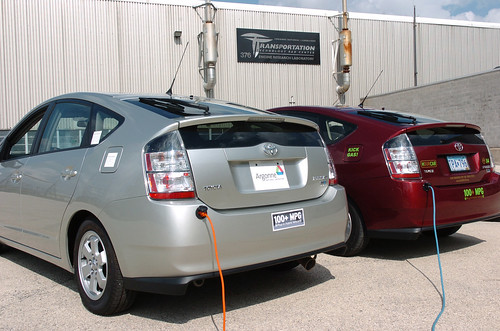With more and more electric car makers ready to blitz the market with Plug-in Hybrids Electric Vehicles and Plug-In Electric Vehicles, it is time the local communities took a stock of the supporting infrastructure necessary for feed these voltage-hungry vehicles. The Seattle PI takes a look at the readiness of Seattle to handle the surge of electric vehicle. Here are some interesting excerpts from the article:
Is Seattle charged for electric cars? Local electric car boosters think so, event though electric cars — other than such hybrids as the Prius — have not captured the fancies of more than a few people in the past 20 years.
“There’s a perfect storm this time around,” said Steve Lough, president of the Seattle chapter of the Electric Vehicle Association, who drives a 2000 Honda insight gas-and-electric hybrid.
On Aug. 5, the federal government announced that it will provide almost $100 million to install roughly 2,500 electric vehicle chargers each in the greater metropolitan areas of Seattle, Phoenix, Nashville, Portland and San Diego.
Roughly $20 million will go to Seattle for 2,550 chargers, Read said.
About 40 firms, including Nissan and eTec, will match the federal appropriations. Local governments will not be required to provide matching money, Read said.
This experiment is timed with Nissan’s planning to sell a new electric car — the “LEAF” — in late 2010. It hopes to initially sell 5,000 cars evenly split among the five metro areas.
This timing roughly coincides with General Motors’ plans to put possibly 10,000 of its all-electric “Volt” cars on the market in late 2010.
By comparison, Seattle has the nation’s largest chapter of the Electric Vehicle Association — with 230 members.
Local owners said recharging electric cars lead to different habits from refueling conventional vehicles.
“You basically plug it in whenever you park it,” said Dan Davids, owner of a 2002 Toyota RAV4-EV and president of the nationwide Plug-In America organization.
Fulling charging a car with a conventional 220-volt installation could take four to eight hours. So-called “fast” chargers with extra oomph could take 15 to 30 minutes to do the same.
But local electric car owners said those figures are misleading.
These cars rarely need full charges with the accompanying long repowering times, they said.
Electric cars are usually charged nightly at their homes. If recharged at business locations, the new power mostly “tops off” a battery usually containing most of its original charge, they said. The same “topping off” would occur when cars would be recharged at businesses.
Between the small amounts of electricity and the lack of wear-and-tear on moving engine parts, they estimated it costs about 2 cents a mile to operate their vehicles.
The three are optimistic that a major hurdle to owning electric cars could be finally conquered — the initial price tag. The Tesla Roadster — with about 700 sold so far — goes for $109,000. Many models of electric cars have been in the $50,000 to $100,000-plus range. “You’re financing the research and development for the next generation of technology,” Morrison said.
The Volt’s expected price tag is about $40,000 with a federal tax credit of $7,500 earmarked for early buyers. The same tax credits will go to buyers of the first LEAFs, which are expected to go for $25,000 to $33,000.


